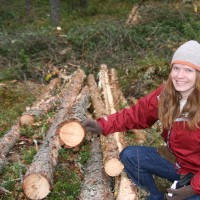Katie Fernholz – Dovetail Partners Inc.
 Katie Fernholz
Katie Fernholz
Executive Director – Dovetail Partners, Inc.
katie@dovetailinc.org
Kathryn (Katie) Fernholz has been a leader within the forestry community in the Upper Midwest through her service as Chair of the Minnesota Society of American Foresters and her appointment to the Minnesota Forest Resources Council. She is a member of the Board of Directors of the College of Food, Agricultural and Natural Resource Sciences Alumni Society, and served as a member of the Advisory Board for the Blandin Foundation’s Vital Forests/Vital Communities Initiative since 2004.
Katie has worked on development and forest management issues in a range of roles. With a consulting firm, she was a member of the environmental services department where her work included natural resource inventories, comprehensive planning, environmental impact assessments and the use of Geographic Information Systems (GIS). While working for the Community Forestry Resource Center, she developed and managed a group certification project for family forests and worked to increase local capacity to provide forest management and marketing services compatible with certification standards. Katie is an experienced forest certification lead auditor.
How has VFVC influenced the way you work?
It helped amplify and promote the idea of collaboration in forestry and natural resources work. The sector has always strived to use this approach, and VFVC emphasized it as a tool.
How has VFVC influenced the way forestry is viewed in Minnesota?
VFVC illustrated the fact that forestry is about more than trees, foresters and loggers. At its core, all parts of the state are connected to forestry; the initiative showed how impactful and beneficial the sector is.
It engaged broader audiences, including areas such as economic development, outside of the traditional primary and secondary forest products industry. The Biobusiness Alliance, for example, is including forestry as part of its work. VFVC also engaged policymakers throughout the state – LCCMR (Legislative-Citizen Commission on Minnesota Resources) and the MN Forest Resources Council, for example.
And, VFVC helped with raising awareness and developing concrete actions. Forestry is not the only thing people are being asked to care about. So, we have to show how we provide benefits at a large scale. VFVC helped illustrate that forestry is not just a little niche — it’s really a network. It’s not just a forests-thing, or a northern Minnesota thing, but a driver that provides jobs from north to south and touches the lives of all Minnesotans. VFVC helped demonstrate that, and once you can demonstrate that, people start to realize that forests, as an issue, should be a higher priority.
What aspect (or aspects) of VFVC do you think may have a lasting impact on you, your organization, the forest or the state?
Statewide, VFVC was helpful in creating supporting documents that have a longer shelf life, and that will be instrumental in decision making and priority-setting for a long time to come. They provided a set of desired outcomes that people can pick up and run with, especially around productivity.
For Dovetail Partners, a relatively young, nimble, and flexible organization, VFVC happened at a time when we were still setting priorities and deciding what to focus on. The initiative’s work is something we can incorporate into our programs and products. For example, VF/VC videos and reports are content we’ve added to our web site.
How do you see your organization continuing the work that began as part of the program?
Personally and professionally, VFVC created time and space to think about and explore issues with colleagues. Those of us who work in forestry on a day-in and day-out basis always have key issues in the back of our minds, and VFVC really brought together key people to dig into opportunities, issues and trade-offs. It was a great creative growth opportunity.
What do you hope people perceive about Minnesota forests?
I hope people realize forestry is not just some narrow sector for loggers and paper mills. It reaches out to every Minnesota household. Everyone who uses wood products, or likes to hike in the woods, or cares about energy alternatives – there’s something that touches everyone.